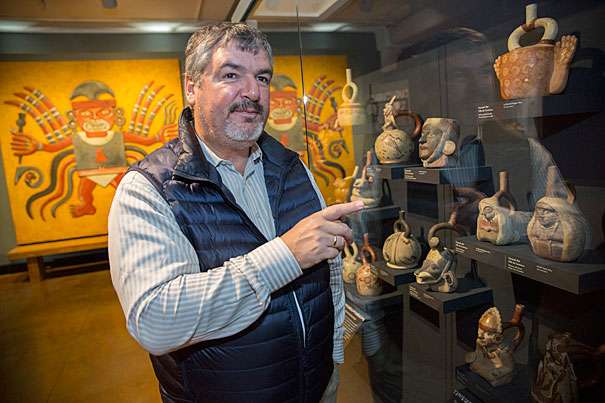“When I started as a young student, 25, 30 years ago, we thought the Moche was a culture led by powerful kings, warriors, or priests.” – Archaeologist Luis Castillo

PHOTO: phys.org

PHOTO: phys.org
SAN JOSÉ DE MORO, PERU – Archaeologists have uncovered a huge chamber tomb housed in the heart of a ceremonial center for the pre-Colombian Moche civilization. The tomb was found on the northern coast of Peru, and it’s shattering everyone’s misconceptions about the power dynamics in the ancient Moche civilization.
The site was first excavated in 2013. Researchers found an intricate coffin inlaid with copper. Inside of it was a 1,200 year-old skeleton. The tomb was filled to the brim with precious artifacts, including expensive pottery, a silver goblet, and a ceremonial knife. The skeleton was found to be female. She’s wearing a rich headdress, a beaded necklace, and is surrounded by sacrificial victims.
She’s one of eight other identical tombs found over the course of 25 years, and she’s turning the assumptions about the Moche culture made by researchers upside down.
The Moche were the first civilization in the Americas that had a governmental state. They ruled the northern coast of Peru just before the famous Incan empire between the first and eighth centuries. They’re contemporaries with the Mayans in Mexico and Central America. They flourished, eking out a life from the Peruvian desert through scientific irrigation, built huge pyramids out of adobe, and had a complex religion that held them together across miles of Peruvian desert, mountains, and jungle.
Until now, they were believed to have a single ruler, and were believed to be a male-dominated culture. These new tombs are calling both those assumptions into question.
In light of recent discoveries, including the Señor de Sipan, a find which is comparable to King Tutankhamen’s tomb in Egypt, and the Señora de Cao, a warrior queen buried with ceremonial war clubs found off the coast of Northern Peru, they believe that the Moche lived as a set of city-state like communities ruled in equal parts by men and women.
This new discovery of this Moche princess’ burial has solidified this new conception of the Moche people. Archaeologists can no longer deny that women ruled alongside men in this ancient Peruvian civilization.
“These women were among the most important individuals in their society,” said Castillo. “Their elaborate burials are narratives of their lives, and the ornaments they were buried with are indicators of their high status.” – Luis Castillo
But, how do they know she was a ruler, and simply not the sister, wife, or mother of someone important? Well, they resemble figures drawn in ancient Moche art. The Moche had no writing system, but, similarly to Ancient Greece, they told stories about their beliefs, their mythology, and their way of life on ceramic pots. A popular subject was human sacrifice.
You may remember that each woman found in their tombs, including the latest, wore beaded necklaces, headdresses, and were buried with a silver goblet. Well, in these depictions, the priestesses wore a headdress and were depicted holding goblets made of silver filled with their sacrificial victims’ blood.
The Moche priestesses found in the tombs were also well-fed and physically healthy, pointing to their status and wealth. It’s clear that these women were important people, influential people, who held positions of power in the Moche civilization.
“They were not the sisters, the mothers, or the wives of somebody powerful,” Castillo said. “In all the burials, the women had a status associated with Moche priests. They were priestesses, but they could have also been rulers. In ancient cultures, political and religious power were blended, and the rulers were often the priests.” – Archaeologist Luis Castillo

